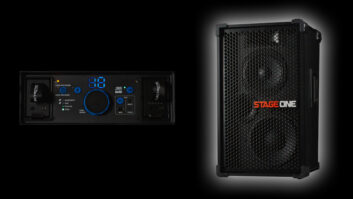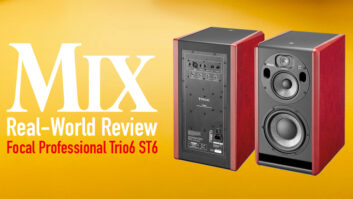Tech support. Two words that strike terror in the hearts of studio personnel and manufacturing executives alike. The former because they know that once they come into contact with the dreaded tech-support phone tree, they may never get out alive, and certainly not with their senses of humor or civility intact. The latter because it means they have to keep staff on the payroll and give them desks, phones and training, despite the fact that, as far as they can see, they do nothing positive for the bottom line. And let’s not forget to pity the poor support staffers themselves-they’re at the bottom of the corporate ladder, and yet they need to be more expert about the products than many of the executives, or sometimes even the designers.
But until we develop products that are completely foolproof, get along well with everything else in the electronic sandbox and work as advertised 100% of the time (I think the last piece of computer software that met that description was MacPaint rev 1.0), tech support will remain a necessary evil for those of us on both sides of the cash register.
Does calling tech support always have to be such a painful experience? Are there ways to minimize the time wasted and maximize the value of the interaction?
Like many people, I try to use tech phone support absolutely as little as possible. One of the reasons is that I lose my temper far too easily. If I have to wait on hold more than three minutes, I get indignant. When the poor slob who picks up the phone after that interval can’t find me in the computer (I’m responsible for a lot of installations in a lot of places, and I can’t always keep track of whose name I might have registered something under), I get sarcastic. And when they try to put the blame on somebody else’s product, I get furious. It doesn’t matter if they’re right-by the time I get to that point, I am so upset at the futility of it all that I’d go ballistic if they were to ask me my ZIP code.
Part of my problem comes from having done tech support early in my career, when professional music software was just starting to appear. Everything was new then, and our customers were struggling with every aspect of computers (“Why am I plugging my interface into something with a picture of a telephone?”), MIDI (“Which end of the cable goes to the ‘In’ jack?”), and digital synths (“How do I adjust the filter resonance on my DX7?”). It seemed to me, in my arrogance, that many of the questions came from people who were simply way too stupid to be using our product. I wanted the person on the other end of the line to be smart, so that I could get him over that last hurdle standing between him and his music. I would get satisfaction out of that kind of conversation-not out of telling somebody which way to insert a floppy disk (“But this disk isn’t floppy, it’s really stiff!”).
On the other hand, I didn’t expect callers to be smarter than I. But since I got out of the manufacturing side of things, I have found that often when I call up a company’s tech support line, I know a lot more about the product than the person I’m talking to. And this hasn’t helped me keep my temper any better, you can be sure.
All of us have expectations about the gear we buy: It will be competently manufactured, well-documented and glitch-proofed. The first is almost always true (although there have been notable exceptions), the second is iffy and the third is, let’s face it, impossible. There are far too many variables in all of our systems for any manufacturer to take into account all possible interactions. This is why companies like Digidesign post a list of “supported” hard drives and CD-ROM recorders on their Web sites: Get a drive that’s not listed there at your peril. A problem with this, of course, is that the product cycles have become much shorter than the companies’ testing cycles, so by the time an “approved” list is compiled, the drives on it have been discontinued by the manufacturers-it’s like trying to find a washing machine that’s been given a “Best Buy” by Consumer Reports.
Reviews in magazines like Mix or Electronic Musician can only help so much because reviewers are testing the gear only in one particular situation, and they will usually have a direct line to some higher-up at the company should anything go wrong. The last thing the company wants is for the reviewer to mention that something is broken. (There’s a new trend in reviews toward the writer calling the company “blind” and evaluating the waiting time and the skill of the support person. This should be encouraged.)
A lot of companies have put their technical-support documents and databases online, organized according to product and topic, and even equipped with a search engine. unfortunately, my experience with most online support systems has not been particularly fruitful. I rarely find exactly the right circumstances that will explain my predicament, and so I end up wasting all that time…when I could have been on hold. I still think this is a great idea, and companies should continue to beef up their online help systems and make them smarter and more responsive. But don’t send your tech support staff home just yet.
“Hey, Mr. Insider!” I hear you cry. “You’re a big-time Mix writer and industry hotshot. Surely you don’t have to wait on hold forever on tech support lines!” Well, in some cases I don’t-but it doesn’t get me results any faster. Dropping my name to some poor tech-support shlub never helps. But since I usually have some kind of relationship with someone else in the company, usually in the marketing or PR departments, I can bypass some of the aggravation. Maybe the chief product specialist and I once started a company together, or I’ve done some consulting or written a manual for them, or I’ve reviewed a product of theirs, or, in one memorable case, it’s because I found myself at dinner sitting next to some guy and we both discovered we were serious Firesign Theatre freaks. In the ten years since then, our conversations have consisted entirely of dialog from “Nick Danger, Third Eye.” Yes, I can call up one of these people and complain to them (“What’s the bird’s-eye lowdown on this caper?”), but they will eventually have to refer me to tech support-who then call me when they’re free. So while I may not have to wait on hold as much as you, I still have to be able to explain my situation to the tech.
And this special privilege of mine only extends to the audio industry. You think I get the same treatment from Apple Computer? (I have known people there, but invariably as soon as I get friendly with them, they leave or get sent over to another division.) Or the folks who write Norton utilities? Or Netscape-whoops, I mean AOL? Or makers of video cards or hard disks or printers? Or, God help us, Microsoft? I’m afraid even Mr. Insider has to hang out with all the rest of you where “We’re all Bozos on This Bus.”
So how do you make this experience tolerable, both for you as a customer and for the poor soul dealing with your problems at the company? Before I get to the answers to that question, I have a little story about a recent experience with two tech support staffs. Since this story has a happy ending, I will name names.
Once upon a time, oh, about two months ago, I decided it was time to stop depending on Jaz disks for my Pro Tools system and buy some serious storage. After all, Jaz’s promise of “$100 per Gigabyte-forever!” isn’t all that attractive now that $400 9-Gig drives are common. Of course, this got me thinking about the first hard drive I ever bought: a 20-meg job from Apple that cost me, with my academic discount, $1,200 in 1986. Storage prices in 13 years have come down by a factor of something like 1,500. Pretty awe inspiring. So I called up Other World Computing, an Illinois mail-order house that advertised in Macworld, and ordered a Quantum Atlas II 9.1-Gig, which looked like it would fit the bill. Well, they told me, the Atlas IIs were all gone, and so, in fact, were the Atlas IIIs. The exigencies of dead-tree publishing being what they are, new product cycles are now not only shorter than review cycles, they’re shorter than magazine ad deadlines. The Atlas IV, of course, was too new to make it to Digidesign’s list, but since the previous models were there, I figured, what could go wrong? So that day an Atlas IV was on its way to me, with a 50-pin connector on the case so I could hook it up to my ancient NuBus-based Pro Tools system.
But it didn’t work with my Pro Tools. My Mac saw it just fine, but as far as the Pro Tools card was concerned, I might as well have stuck a wad of chewing gum on the end of the cable. Wanting to avoid calling tech support at any cost, I went to Digidesign’s Web site and did a search in their support database for any clues.
Despite my previous lack of success with such systems, this time I thought I found the answer: My old NuBus card needed a SCSI chip upgrade to run any new drives. So I called someone I knew at Digi, and he had a support tech named Tom call me an hour later. “Sure,” Tom said. “Send it over, we’ll upgrade the chip and get it back to you. Total downtime should be about a week. And here’s my direct line if you need any help later on.” Interestingly enough, though, he couldn’t find the page in the support database that described the problem. I read him the uRL that was printed on the page itself, but it wouldn’t load. It turned out that someone had changed the page’s uRL but had forgotten to change the text on the page itself.
Sure enough, a week later the card came back, but accompanying it was a disturbing note from the service department: “SCSI upgrade already installed and working properly. Swapped card for new one anyway.” I installed it, hooked up my new drive and…nothing.
I called Tom and got his voice mail. Two hours later, another tech, Beto Carvalho, called back. Beto’s theory was that the drive wasn’t terminated correctly. The drive itself uses a 68-pin cable, and he figured that when they wired it to the 50-pin connector I had requested, they left the other 18 pins hanging, without putting termination resistors on them. This would cause the card not to see the drive. And then he did an astonishing thing: He offered to have me send the drive to him, and he would install terminators for the 18 pins and send it back.
I was impressed by this generosity, but figured I’d check with the hard disk vendor first, to see if this was true-I was also a little concerned that Digidesign’s futzing around with it would void the drive’s warranty.
No, said the vendor, that’s not the problem-we always terminate the extra pins. But, they added very sheepishly, there is this other problem. The Atlas IVs are SCSI-3 drives, and Quantum, during their initial manufacturing run, forgot to make them backwards-compatible with SCSI-2 systems. (My Pro Tools card used SCSI-2.) There was a firmware upgrade that could be downloaded from Quantum’s Web site, but you needed to have the drive hooked up to a PC to use it. So my choices were: Bring the drive over to a friend with a PC (as if I had any) and do the download thing; send the drive back to the vendor and they would do the firmware upgrade; or send the thing back to the vendor and get a different drive. They offered me an IBM at the same price, with the same specs, which they knew was SCSI-2 compatible and which they would be happy to swap out for me. I insisted they pay shipping both ways, since this was their damn fault, and I had already paid to ship the Digi card across the country twice. To this they readily agreed.
Imagine my surprise three days later when the new drive arrived and I hooked it up to my computer-and it had 18.2 Gigs of space! I checked the invoice, and there was no mistake; they had sent me a drive twice the size of the one I ordered. (This meant the change factor in the storage dollar/byte ratio since 1986 had now jumped to 3,000.) And the invoice had another surprise: They were crediting my Visa card $44. Furthermore, it worked with Pro Tools.
I called Beto back and told him the whole story, and he was mighty pleased to hear the outcome. “People don’t talk about their successes with tech support very often-usually they just complain about the problems,” he said. “You know, I would love to write an article on how to contact and deal with tech support departments more efficiently. I deal with people every day who seem to know how to ‘work the system,’ and therefore get their problems solved more promptly, and other people who seem to do everything to slow down the resolution of their problems.” Never one to pass up a good column idea, I suggested a collaboration. You’ll see it in this space next month: Beto’s Six Rules for Getting Good Customer Support -With Paul’s Addenda and Corollaries.
So now that the calendar has ticked over, and some of us are collecting rainwater in buckets and eating fresh squirrel by the warm glow of a garbage-can fire, the need for tech support isn’t going to go away. Just don’t forget the flashlight batteries.







